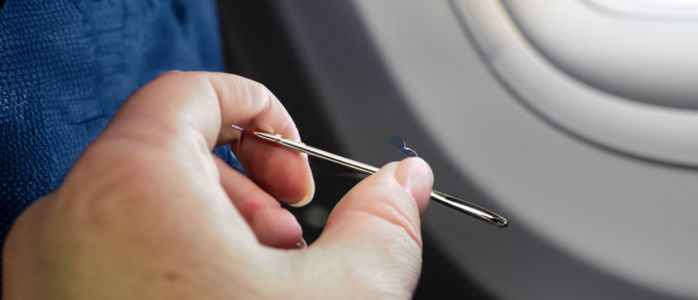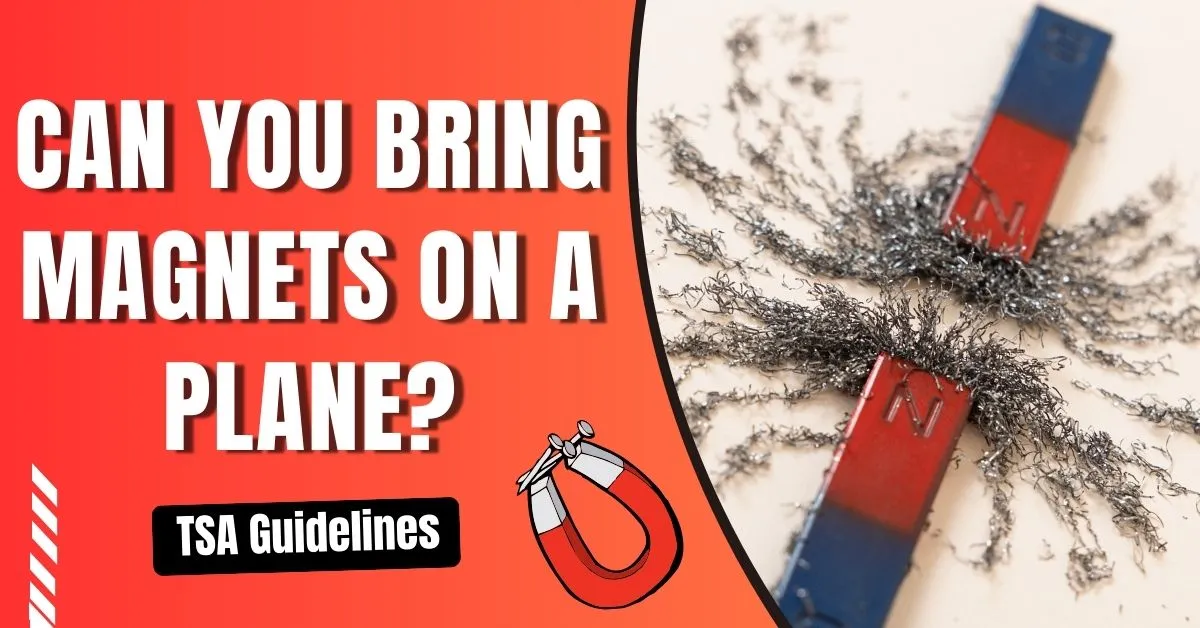Can You Bring A Sewing Needle On A Plane?

When it comes to travelling by plane, it’s important to know what items are allowed in your carry-on luggage. One common question that arises is can you bring a sewing needle on a plane. Understanding the regulations regarding this item is crucial to avoid any inconvenience or confiscation at the airport security checkpoint.
Get simple & clear information about whether you can bring a sewing needle with you on a plane. Get guidelines & restrictions set by the relevant authorities to help you make informed decisions and ensure a smooth & hassle-free journey.
Whether you’re a frequent traveller or embarking on your first flight. Knowing the rules regarding items like sewing needles will contribute to a stress-free and enjoyable travel experience.
Can I Bring A Sewing Needle On A Plane? (Through TSA)
When it comes to the question- are sewing needles allowed on planes? It’s essential to understand the rules and regulations regarding what items are allowed in your carry-on luggage.

One item that often raises questions is the sewing needle. Whether you’re a passionate crafter, seamstress, or simply need to bring a needle for a specific purpose, it’s important to know whether you can bring it with you on a plane.
Here is an overview of the regulations and considerations regarding bringing a sewing needle on a plane:
- It’s important to review the specific guidelines provided by your airline and the country you are travelling to or from.
- Pack them properly to prevent any accidental injury.
- The needle should be securely stored, such as in a needle case or a travel sewing kit.
- Avoid packing sharp needles loose in your bag, as they may pose a risk to security officers during screening.
- The length and type of sewing needle may impact its permissibility on a plane. Check with your airline for any specific length or type limitations.
- In addition to sewing needles, be mindful of other sewing-related items you may be carrying, such as scissors or thread cutters.
- For bringing things like eye drops on a plane along with things like liquor on a plane, check out the TSA regulations first.
- Other sharp things apart from sewing needles like Gillette razors on plane also should be cross checked by TSA regulations.
Sewing Needles TSA Regulations
When it comes to packing for a flight, it’s important to be aware of the sewing needles TSA regulations regarding what you can bring on board. One common item that travellers often inquire about is sewing needles.
Know about the TSA regulations concerning sewing needles. By understanding these guidelines, you can ensure a smooth and hassle-free security screening process at the airport.
Can I Take A Sewing Needle On A Plane In Carry-On & Checked Baggage?
In general, you are allowed to bring knitting needles and needlepoint tools in both your carry-on and checked baggage. This means you have the option to keep these items with you in the cabin or pack them in your checked suitcase. However, it’s essential to be aware of specific restrictions and guidelines to avoid any issues at the airport security checkpoint.
Circular Thread Cutters and Blade-Containing Tools
If you are carrying circular thread cutters or it includes any other sharp cutters or needle tools with blades. It must be kept in checked baggage and not in carry. These tools are not permitted in your carry-on luggage. It is due to the potential risk they pose to the security of the aircraft cabin.
Scissors Size Restrictions
When it comes to scissors, the TSA allows you to keep scissors smaller than 4 inches in your carry-on baggage. Scissors that meet this size requirement are generally considered safe for air travel. However, it’s important to measure the blades from the fulcrum point to the tip. It helps to determine if they fall within the acceptable range.
Other Considerations
While the TSA provides general guidelines, it’s important to note that individual airline policies may vary. Some airlines may have additional restrictions or guidelines regarding sewing needles or related tools. Therefore, it’s recommended to check with your specific airline before travelling to ensure compliance with their regulations.
Additional Sewing Supplies and Craft Items
You might want to know that other than whether can you bring a sewing needle on a plane, what other items are permitted. When travelling, you may want to bring along other sewing supplies or craft items to keep yourself busy or work on your projects.
While regulations may vary, here are some common items you might consider bringing and guidelines to keep in mind:
- Thread: Small spools of thread are generally permitted in both carry-on and checked baggage, allowing you to bring your sewing essentials wherever you go.
- Needles and Pins: Whether it’s sewing needles or hand-sewing needles and pins, these are usually allowed in both carry-on and checked baggage, providing flexibility for your crafting needs.
- Embroidery or Cross-Stitch Supplies: You can pack your embroidery or cross-stitch supplies in both carry-on and checked baggage. It ensures your creative projects are with you on your journey.
- Crochet Hooks or Knitting Needles: If crochet or knitting is your passion, rest assured that you can bring your crochet hooks or knitting needles in both carry-on and checked baggage. Enabling you to work on your projects while travelling.
- Beads and Jewelry-Making Supplies: For beads and jewelry on a plane in carry-on bag supplies, it’s advisable to pack them in your checked baggage, particularly if they have sharp edges or contain liquids. Ensuring a smooth and secure transit.
- Craft Scissors: Small craft scissors with blades under 4 inches are typically permitted in carry-on luggage, allowing you to keep your essential cutting tools within reach during your journey.
Is It Allowed To Sew, Knit/Crochet on a Plane?

Yes, you are generally allowed to sew, knit, or crochet on a plane. These activities can be enjoyable ways to pass the time during a flight. However, it’s important to be mindful of certain considerations and guidelines while engaging in these activities onboard:
- Use caution when handling needles or sharp objects to prevent injuries.
- Consider using rounded or plastic-tipped needles to minimize any potential risks.
- Ensure that your yarn or thread is neatly contained to avoid any entanglements with other passengers or flight equipment.
- Keeping your supplies organized in a bag or pouch can help prevent any inconvenience.
- Avoid extending your knitting needles or crochet hooks into the personal space of other passengers.
- Maintain awareness and consideration for fellow passengers.
- Avoid any activities that may create excessive noise or inconvenience to those around you.
- Always comply with any instructions or requests from the flight crew.
- If they ask you to temporarily stow your project during specific phases of the flight, kindly oblige to ensure everyone’s safety.
Can You Bring Felting Needles On A Plane?
Felting needles are generally not allowed in carry-on baggage when travelling by plane. Felting needles are sharp, pointed objects that can be considered dangerous & pose a potential security risk. As a result, they are typically prohibited from being brought onto the aircraft in your carry-on luggage. While felting needles are generally not allowed in carry-on baggage, you can safely store them in your checked luggage without hassle. Here are some key points to guide your needle-felting travel adventure:
- Pack your felting needles securely in your checked luggage to avoid any issues at security checkpoints.
- Although small, felting needles have sharp points like that in fishing hooks on a plane in the luggage that raise security concerns.
- Unlike craft items like box cutters or scissors, felting needles lack actual blades, making them acceptable in checked baggage.
- Wrap your needles carefully in padding or a case to prevent damage during handling.
- At customs, confidently declare your needles as crafting tools to avoid confusion or delays.
- Consider bringing a small project and some pre-felted wool to work on during your flight, showcasing your crafting passion even without the needles.
- Double-check with your chosen airline for any specific regulations regarding craft tools.
Packing Tips
Now that you know whether can you bring a sewing needle on a plane. To ensure a smooth experience at the airport security checkpoint, consider these packing tips for sewing needles and related tools:
- Sewing needles generally fall under the “tools in a plane in luggage bag” category & are allowed in both carry-on & checked baggage. However, airlines and countries may have different regulations, so double-check with both the TSA & your specific airline before packing.
- Invest in a dedicated needle case or travel sewing kit. These keep your needles secure & prevent accidental pricks for you and security personnel.
- Avoid tossing your needles loose in your bag! Place your needle case or kit inside a zippered pouch or another secure container within your carry-on or checked luggage.
- If you’re carrying multiple needle cases, label them with the needle sizes or types for easy identification during security checks. This saves you time and avoids any unnecessary confusion.
- Opt for smaller needles whenever possible. They’re less likely to raise eyebrows and are generally more practical for in-flight crafting projects.
- Pack some thread & mini scissors to complement your needles! This way, you can whip up a quick repair or work on a small project during your flight.
Conclusion
In conclusion, you are allowed to bring a sewing needle on a plane. According to TSA guidelines, sewing needles are considered permissible in both carry-on and checked baggage. However, make sure to take precautions such as packing them securely to avoid any accidents during travel.
FAQ’s: Can You Bring a Sewing Needle on a Plane?
If you are wondering whether to bring a sewing needle along with you, here are some FAQs on can i bring a sewing needle on a plane? Find out all the essential information with these questions to assure yourself. Here are the frequently asked questions below:
Yes, in general, they are allowed in carry-on luggage. However, there are size restrictions for scissors and other sharp objects.
Generally, there are no specific size limitations for sewing needles. However, it’s important to pack them securely and handle them with care to prevent injuries.
Yes, you can pack sewing needles in your checked baggage without any restrictions.
All types of sewing needles, including hand-sewing needles, tapestry needles, and embroidery needles, are generally allowed on a plane.
While not mandatory, it’s recommended to store sewing needles in a secure container or a dedicated needle case. It will prevent accidental injuries and facilitate their identification during screening.
No, sewing thread and embroidery floss are typically allowed in both carry-on and checked baggage without any restrictions.
Yes, you can bring a sewing kit that contains multiple needles in both carry-on and checked baggage. Ensure that the kit is securely packed and organized.
In most cases, sewing needles do not need to be declared separately. However, always follow the instructions of the security officers and be prepared to remove any items for further inspection if requested.
Felting needles are generally not allowed in carry-on luggage on a plane due to their sharp and pointed nature. It’s advisable to pack them in checked baggage.





Comments